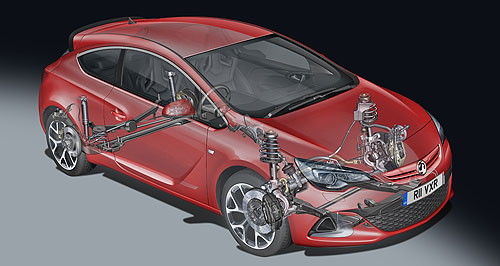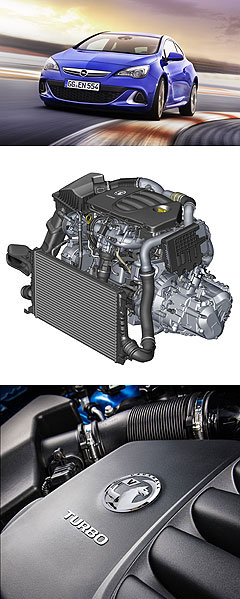Opel reveals Astra OPC technology
BY HAITHAM RAZAGUI | 10th May 2012

The Astra OPC, which is not yet confirmed for Australia, will use a motorsport-derived limited-slip differential and modified HiPerStrut front suspension to minimise torque steer from the engine’s 400Nm of grunt.
Sophisticated three-mode electronic suspension control is also fitted, alongside three electronic stability control settings.
Opel claims extracting more than 200Nm per litre of engine capacity puts the Astra OPC at the top of its class for specific output, complementing the 209kW peak power of the 2.0-litre turbocharged four-cylinder petrol unit.
Unlike electronic systems like that employed by powerful front-drive cars like the Volkswagen Scirocco R, Opel has attempted to tackle the traction issues that typically afflict such vehicles via mechanical means.
Opel says the HiPerStrut (abbreviation for High Performance Strut) front suspension is designed to reduce wheel camber changes during cornering, with the benefits of improved steering feel and “filtering out” torque steer under hard acceleration.
The setup, which debuted on larger cars like the Opel Insignia OPC and Saab 9-5, is standard across the Astra GTC range, with modifications for the high-performance Astra OPC.
In addition, the limited-slip differential is produced by motorsport manufacturer Drexler and is derived from the unit used in the smaller Corsa OPC Nurburgring Edition driven by GoAuto last September.
The diff is set up to enhance on-throttle traction while reducing lock-up under deceleration.

The electronic dampers feature ‘ramp-control’ claimed to ensure the wheels stay in contact with the road immediately after hitting a bump, which Opel says gives the car “a soft landing even when the springs rebound on an uneven surface”, and ‘roll control’ to reduce lean during cornering.
The Astra OPC’s handling was signed off at the Nurburgring by the performance sub-brand’s lead engineer, ex-DTM racer Volker Stryek.
In addition to the standard ‘safety first’ electronic stability control setting, the OPC gets Competitive mode, which gives the driver more freedom before interventions are made, plus a third mode that completely deactivates the system.
Opel claims to have achieved a strong balance of power and fuel efficiency with the Astra OPC’s engine, using idle-stop technology to help achieve claimed consumption of 8.1 litres per 100 kilometres and a CO2 output of 189 grams per kilometre.
Despite being significantly more powerful than the 175kW/320Nm previous-generation equivalent, sold in Australia as the HSV VXR, fuel consumption and CO2 output are respectively slashed by 14 per cent and 12 per cent.
Opel says extracting so much performance from a small four-cylinder engine has not come at the expense of reliability.
The car has been subjected to 10,000 kilometres of testing at the Nurburgring “under racing conditions”, which it claims is equivalent to 180,000 kilometres of normal road driving.
Based on an engine used in the mid-size Insignia, the Astra OPC’s drivetrain features a new air intake system developed to feed maximum air to the turbocharger, which comes on boost from 1400rpm.
The turbo has also been modified for durability and to withstand more boost pressure, which is increased 25 per cent over the Insignia – and maximum torque is on tap from 2450rpm, remaining available until almost 5000rpm.
Opel says it has furnished the Astra OPC with a “powerful” engine note and made sure it kept the “jet noise like sound” heard by occupants of the previous-generation car during acceleration from the mid-to-high rev range.